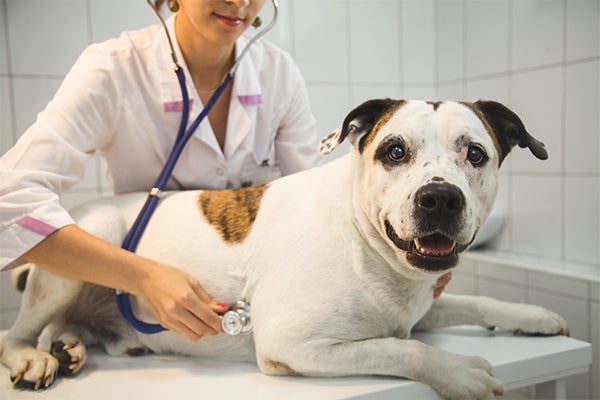September 20, 2018
How Much Will a Vet Visit Cost?
Every pet owner knows that vet care is a routine part of being a responsible pet parent, but not every pet parent knows what vet care should cost from basic preventative care and vaccinations to an unexpected diagnosis.
This article gives an overview of what kinds of expenses to expect and what those expenses are so you’re better prepared before heading to the office. Keep in mind that it’s possible for vet costs to vary widely depending on where you live, for example. It’s also a good idea to talk with other trusted pet parents to get their experience of different veterinary care costs.
What Do Veterinarians Charge For?
Most pet parents cringe when it comes to the vet bill part of a vet visit; however, that is because most do not know what goes into the services their pet receives. The reality is that—in addition to administrative and operating fees—there are many things vets have to charge for in their practice. These are:
- Professional services, which includes the physical exam, medical exam, extended exam, and hospitalized patient exam
- Diagnostic services, which includes blood pressure evaluation and more
- Diagnostic imaging services, which could range from ultrasounds to radiographs
- Lab work services, which includes collecting labs, running, and analyzing samples that test for blood chemistry, leukemia, heartworms, thyroid, immunity, and more
- Surgical procedures
- Anesthesia for procedures, which includes intubation and monitoring
- Hospitalization services, which includes overnight stays, inpatient monitoring, and more
Veterinary fees are generally competitive based on the rates of other veterinarians in the surrounding area as well as the nature of the services offered. Your pet’s weight and size also influences costs for services rendered.
Costs of Basic Preventative Care

Needless to say, all of these services are not part of basic preventative care. During a routine, annual or bi-annual (depending on your pet’s age) preventative care or well-visit, your pet will have a thorough physical exam in which the vet will check your pet’s hearing, vision, teeth and gums, heart function, respiration, skin and coat, musculature, and more.
Average cost of physical exam: $45-$55
Some such visits will also include getting routine vaccinations or vaccine boosters. Recommended vaccines for dogs are for parvovirus, distemper, hepatitis, and rabies. Recommended vaccines for cats are panleukopenia, herpesvirus, calcivirus, feline leukemia, and rabies.
Average cost of vaccines per shot: $15-$28
Costs of Additional Tests and Services
Additional services that might be rendered during a preventative care visit include tests for potential issues such as a fecal exam or heart worm test. The typical costs for such additional tests and services are:
- Fecal exam: $25-$45
- Heartworm test: $45-$50
- Dental cleaning: $70-$400
- Allergy testing: $195-$250 for skin test, $200-$300 for blood test
- Geriatric screening: $85-$110
Costs of Surgery or Unexpected Diagnosis
While on average, routine annual veterinary care might cost between $200 to $400 for dogs and $90 to $200 for cats, unplanned events such as accidents, injuries, or unanticipated ailments can cost a variable amount more.
For example, if you learn your cat has diabetes, it might cost $300 just for your vet to be able to properly diagnose your cat. The total cost of caring for a pet with diabetes will vary depending on the age of the cat when diagnosed and how long the cat lives afterward. While glucose can be monitored and insulin can be managed at home, pets with diabetes often have to visit the vet more frequently for other ailments or for interpreting at-home glucose test results as needed.
Similarly, if, after the $45–$50 heart worm test, your dog does have heart worms, treatment can be $400 to $1,000.
Emergency treatment is another expense that can quickly run upwards of and beyond $1,000. Again, this is circumstantial and depends on what the vet has to do to diagnose and to treat your pet. If the ailment is unknown, the vet will have to do diagnostics and blood work—possibly imaging, to determine what is wrong. After they figure out what is wrong, they still have to treat your pet. If hospitalization is necessary, that will increase the total costs for treatment.
Covering Veterinary Costs

If your pet does have an emergency, you can minimize costs by providing the vet with as much specific information as possible. While not all unexpected diagnoses and needs for long-term treatment can be prevented, attending to routine preventative care, not missing annual check-ups, and getting your pet vaccinated and staying on top of booster shots will help.
To manage costs, consider creating a special savings account to cover your pet’s annual vet bills plus incidentals. If you start saving while your pet is young, by the time they suffer afflictions typical of old age, you will be financially prepared to handle those unplanned diagnoses as well as any other unexpected medical problems that occur along the way.
In addition to preventative care, pet parents can help decrease unplanned medical issues by feeding a natural food especially designed for his or her size, age and breed. Wellness Pet Food for dogs and cats is made with all-natural ingredients and are created to ensure cats and dogs have long, healthy, happy lives.





